BACK TO WEATHER-BLOG MENU
New! Fine Art Prints & digital images for sale-
Welsh Weather & Dyfi Valley landscapes Slide-Library - Click HERE
Late August arrives and with it the promise of some storms with which to finish the week leading up to the final holiday weekend. Yesterday, waiting to hear from a printer about a leaflet I was working on, but also impatient to make the most of a fine day, I headed up for a few hours, armed with camera, food and water into a part of the Cambrian Mountains that I rarely visit these days - the headwaters of the Leri Valley. It seems to get a lot less attention compared to its larger cousin, the Dyfi, unjustifiably, so I thought I'd dedicate a page of images and memories to it, for I have very many.
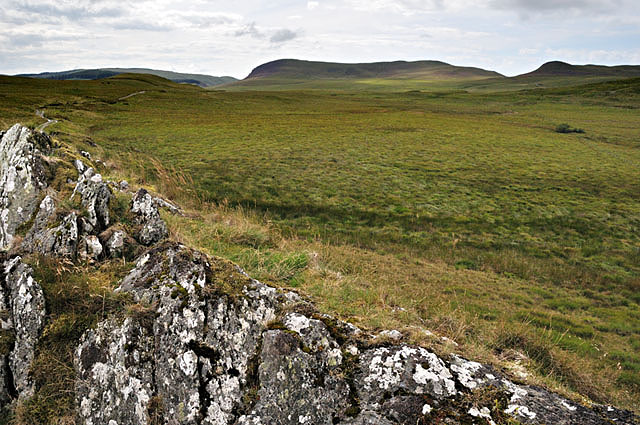
above: the headwaters of the Leri - a wide, gentle expanse of green. Craig-y-Pistyll L and Banc Sychnant R.
Afon Leri begins its life as dark streamlets dissecting undulating tussocks and bright mossy patches in the quiet, empty lands under the shadow of Disgwylfa Fawr. From upland peatlands its headwaters run into the lake of Llyn Craig-y-Pistyll, dammed in the Nineteenth Century to supply water-power to the lead-mines, and on along the rocky gorges and wooded valleys below it makes its way, quietly obeying the laws of gravity, to where it once entered the sea - ten miles downstream - at Borth. Some time ago, men diverted it northward as a straight, levee-bounded canal to its current muddy estuarine outflow amongst the shifting channels and sandbanks of Traeth Maelgwyn. Here, united with Afon Dyfi, it now enters Cardigan Bay.
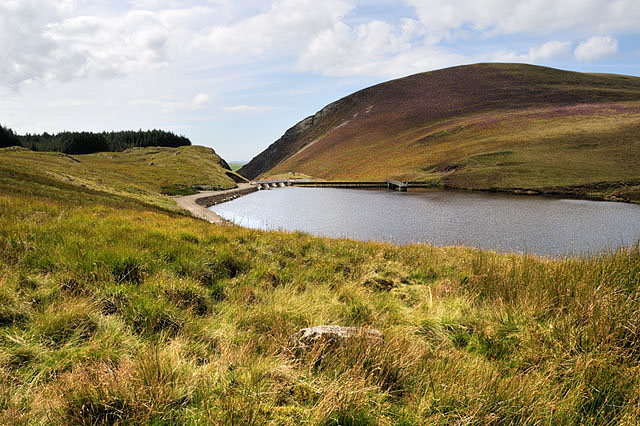
above: Llyn Craig-y-Pistyll and the hill of the same name.
I have lived around this river for many years. From its estuarine reaches I have gathered driftwood for the fire or marsh samphire for the pot and have stalked the summer bass as they run upstream on the flood-tide. Followed up into the low wooded hills towards Talybont there have been the seasonal hunts under the trees for chanterelles. Or, cap-lamp at the ready, the multitude of old mine-workings, where men delved for copper, lead and silver as long ago as the Bronze Age (in some cases) have drawn me into the silence and total darkness of yesterday’s endeavour. The river powered the waterwheels, not only of the mines, but also the mills, where silver was smelted in the Seventeenth Century and, many years later, where Welsh Tweed was made. Above Talybont, there are red-brick ruins, now part-hidden in ground-elder and bramble, where there was a small hydro-plant which kept the lights of Talybont twinkling in the days before the National Grid. In its upper reaches above Bontgoch there are the waterslides and cascades of Craig-y-Pistyll, reached by a two-mile rough track, and where I once spent a winter climbing short ice-pitches, crampons kicking in and duvet-clad, in a freezing easterly gale that seemed to go on for weeks.
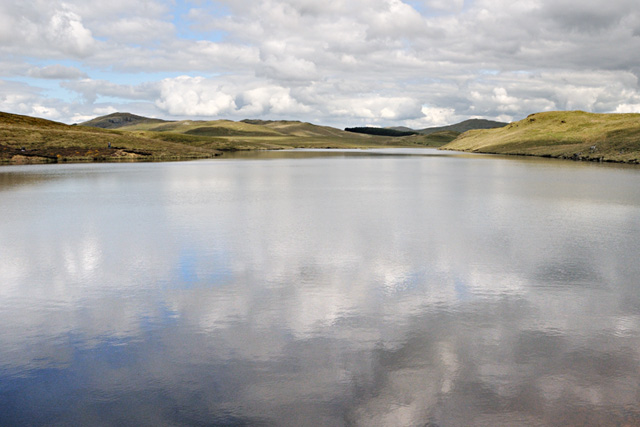
above: looking up Llyn Craig-y-Pistyll to the Leri Headwaters. The prominent hill L is Carn Owen.
I have many memories of the upper Leri Valley from that winter. One of the strangest was the time when I belted the pick of my ice-axe into apparently solid ice, only for a small hole to appear and a jet of water to hit me full in the face. In a matter of seconds, my glasses were covered in ice and had become securely frozen to my hair and my woolly hat. A tricky situation given that I was about ten feet up a vertical ice-step at the time. I extricated myself – how I cannot remember, apart from some kind of blind, panic-stricken groping upward.
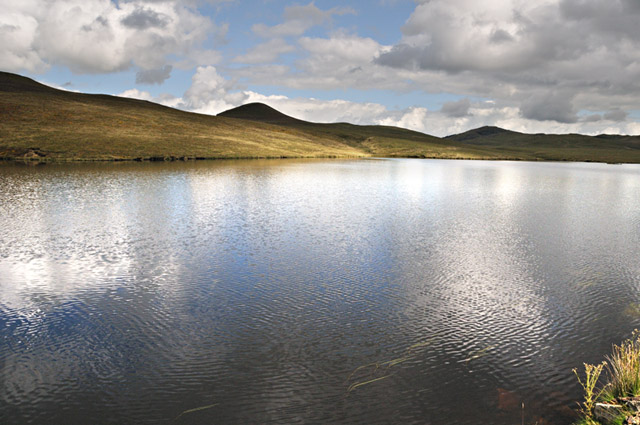
above: Banc Sychnant and Carn Owen across Llyn Craig-y-Pistyll.
Another strange encounter in this valley was during the same winter, 1985 I think it was. I’d spent all afternoon amusing myself, like you do (if you are a climber), by front-pointing up and down small frozen waterfalls and as darkness beckoned I set off down to Bontgoch. The winds sang over drifts of rock-hard snow which filled sunken places, picking out subtle undulations of the landscape, in between wind-scoured ridges now black in the twilight. Hard sheet ice covered the track, so, keeping my crampons on, I crunched along homeward. After about a mile I saw the figure. It was some distance away but definitely heading in my direction – a dark figure with a sack over its shoulder.
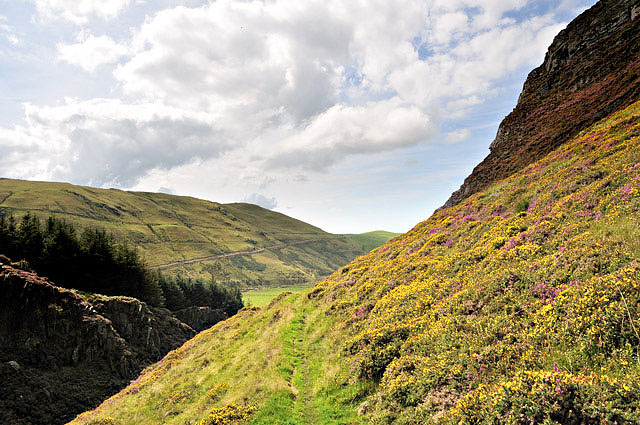
above: Craig-y-Pistyll: the start of the path down through the crags above the gorge.
Not expecting anybody to be about on such an evening, I viewed this new apparition with a mixture of curiosity and a certain amount of fear. The context of this was that many of my mates, some of whom already regarded me as something of an eccentric, were of the conviction that I was completely bonkers to go off into the hills in such weather. Thus, it followed that normal people would be at home, or visiting friends, or in the pub, in front of a blazing fire and conversing on the worst winters they had experienced with standard stock terminology. But here was I, with half of my journey remaining, and this figure between me and it. I gritted my teeth and continued on, by now half-expecting it to suddenly vanish, as apparitions are supposed to. But on it came. Night was now gathering itself very quickly.
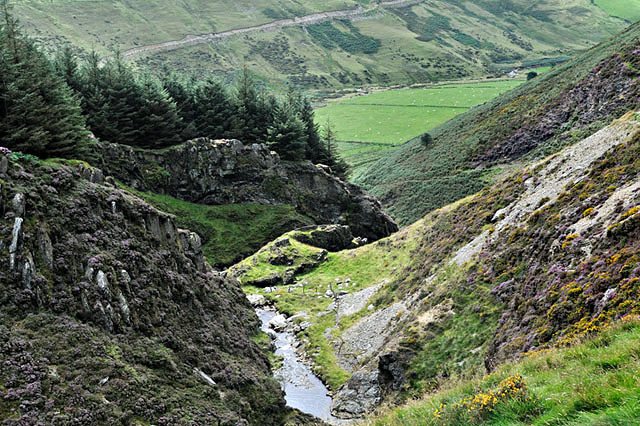
above: Craig-y-Pistyll: looking down from the narrowest section of the path.
The crunch of converging hobnails and crampons met in the lee of an old hedgerow of bent and twisted ash and hawthorn. The apparition spoke and my fear instantly turned to an inner laughter at myself. We swapped notes about the winter weather using standard stock terminology. He explained that he had walked down to Bontgoch, where somebody had dropped off his groceries for him. These were now in the large hessian sack over his shoulder. A heavy coat was tied with bailer-twine. We spoke for a while, then by mutual need set off in our opposite directions as the wind howled down the valley.
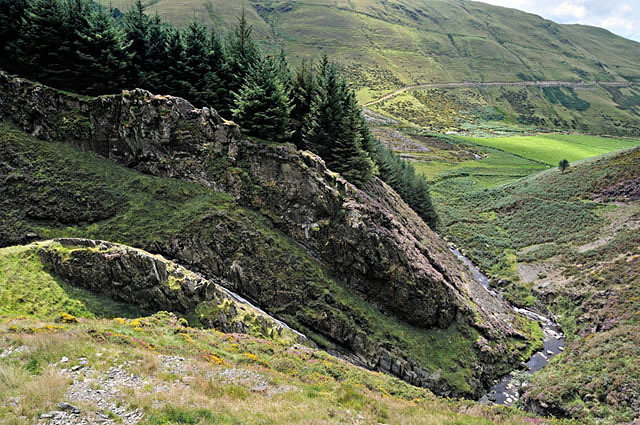
above: Craig-y-Pistyll: the first waterslide (and first ice-pitch, when it freezes up).
I got to know Geraint Llawr-y-Cwm quite well after that. He lived in the farm below the crags, alone with a pack of dogs whose numbers I could never quite count as they milled around me, barking and snapping until he would appear and call them off sharply in Welsh. He’d lived there since he was a boy, had walked to school daily in Bontgoch and now walked there weekly for his supplies. He had no electricity or TV and was quite content in a way which some might find difficult to understand in the modern way of things. He spent his days tending his modest number of sheep and cattle, and would proudly show me each season’s new calves if I was about at the right time.
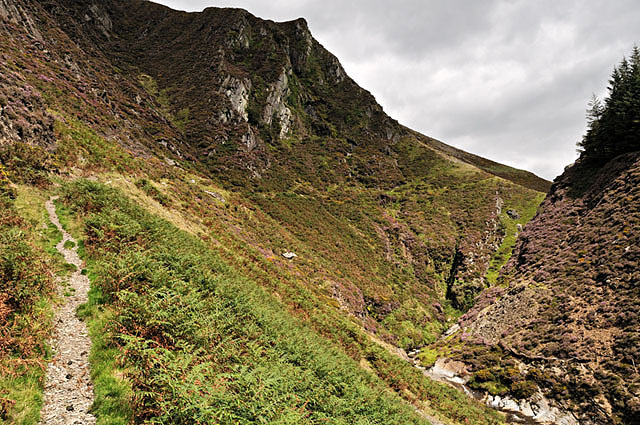
above: Craig-y-Pistyll: the precipitous section of the path.
His knowledge of the hills and their weather was extraordinary. Today we can get all the weather data we need with a few clicks on the Internet. Message-boards are crammed with amateur forecasters vying with one another for the correct interpretation of the dozens of runs and models. Back then, in that valley, all that was necessary was to look at the sky, note the patterns of clouds, direction and feeling of the wind, the behaviour of the valley’s wildlife. You see, these things he knew – from his years of quiet observations. He imparted a lot to me during our hillside conversations – the depth of understanding that comes from a lifetime living with the hills - without the constant radio-clutter of irrelevant information that accompanies our lives on the outside. I listened avidly.
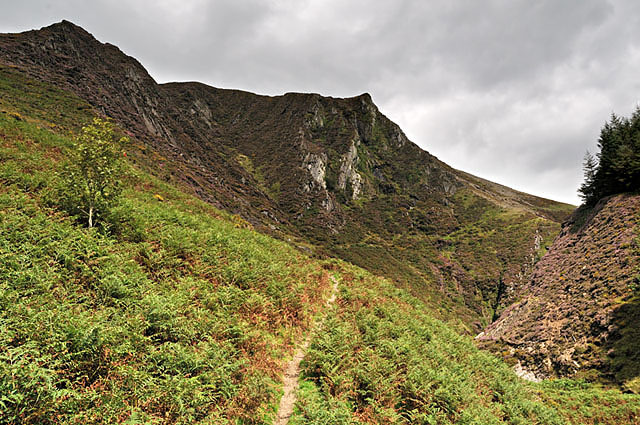
above: Craig-y-Pistyll: leaving the gorge for the valley below.
Amongst everything else that Geraint unintentionally taught me, as a young man – a struggling, somewhat disillusioned final-year undergraduate student - in my early twenties, there was one thing that stood out above the rest. And that was that knowledge might indeed be attained by studying for a degree, but true wisdom is something altogether different. It comes from long experience and the readiness never to stop learning. Today, many years later, our academic institutions still fight one other in the name of Competition and our abilities are expressed by small certificates in heavy-grade paper. Year upon year everything must be bigger and better, bigger numbers presented with wordy self-justification and the language of spin that makes the facts fit the need. All rather abstract and irrelevant in comparison to the quiet and rhythmic life that Geraint lived when I ventured into his valley, a life which many would immediately label as boring, yet put yourself against him, be honest with yourself, and see who is truly the content one.
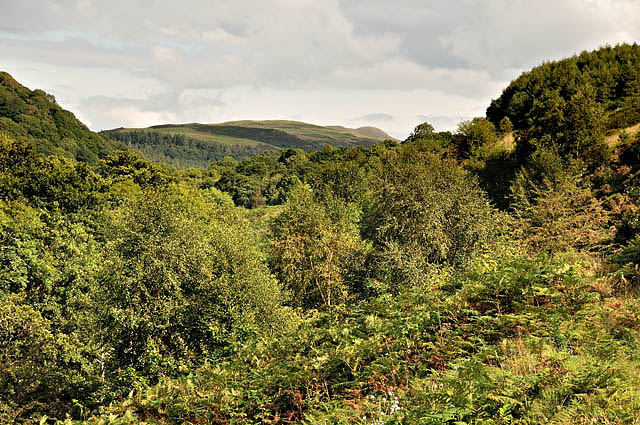
above: the lower Leri Valley is densely wooded. Braich-Garw, above Talybont, with Banc Sychnant in the distance. I remember when this section was mostly short-clipped open turf: it is no longer grazed.
Today, many years later, our grab-it-now, got-to-be-better, time-obsessed, presentation-rather-than-content driven world continues to engulf such places and their people the world over, yet who ever pauses for a moment to question its validity? We stream in and out of our workplaces like incoming and outgoing tides, clogging our roads sat in traffic-jams as our stress-levels build and the air chokes the throat with the acridity of a hundred thousand car exhausts. We have become so far removed from the real world that we, as a species, inherited and now pretentiously redefine as reality. And so, in The Insect Colony, the queens sit central, invulnerable, smug, essentially unaccountable while the workers and drones swarm frantically to and fro until they have outlived their use, shrivel and are sent out to die. And the rubbish piles up. I need to get out. My mind escapes….
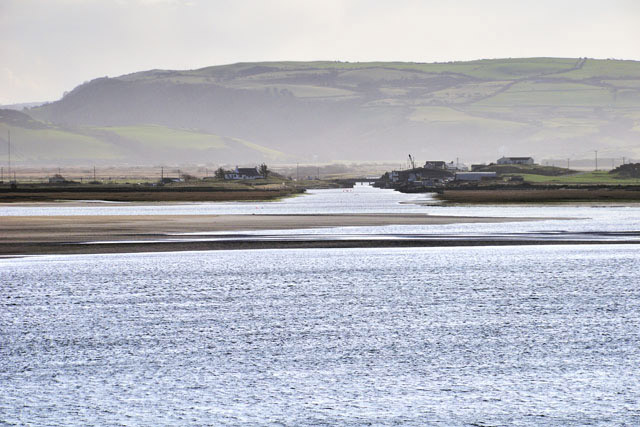
above: the mouth of the Leri (since the 1850s), viewed from across the Dyfi Estuary at Aberdyfi.
Up there, under Craig-y-Pistyll, the chatter of streams continues as another day ends and dusk falls on Afon Leri. Shadows cloak the tree-lined valley downstream where owls call in the darkness. Out over the mudflats it winds seaward on a slow ebb-tide, to where the sewin await sufficient flood-water to run up, up to the place of their birth to renew their species once again. And so, completely outside of - and not giving a damn about - power-breakfasts, performance-indicators, delivering, multitasking and such forth, on the river runs…….with my everlasting thanks.
BACK TO WEATHER-BLOG MENU
New! Fine Art Prints & digital images for sale-
Welsh Weather & Dyfi Valley landscapes Slide-Library - Click HERE